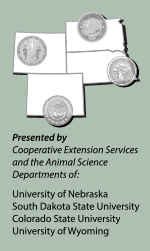Redefining Preconditioning
by Troy Smith, field editor, Angus Journal
RAPID CITY, S.D. (Dec. 5, 2013) — The opportunity to hear a veteran cattle feeder talk about old and new approaches to calf preconditioning likely intrigued cow-calf producers attending the Range Beef Cow Symposium (RBCS) Dec. 3-5 in Rapid City, S.D. That’s because Craig Uden has ample experience with calf feeding. He is co-owner of Darr Feedlot, Cozad, Neb., which receives some 20,000 calves each year. A cow-calf producer as well, Uden understands the perspective of people wanting to prepare their calves for the feedlot, and the perspective of people who manage those calves in the feedlot.
While foul weather prevented Uden from traveling to Rapid City, he delivered his presentation through remote computer technology. Recounting the history of preconditioning, Uden said the management strategy began in the 1960s as an effort to reduce the incidence of bovine respiratory disease (BRD) and its negative impacts to cattle performance in the feedlot.
“Recommendations called for weaning calves for three to four weeks, getting them bunk-broke and applying a comprehensive health program,” said Uden. “Not a lot of that was done back then.”
Things weren’t that different in the 1980s, when Uden began his cattle-feeding career. The focus of so-called preconditioning programs often included “a couple of shots.” Uden recalls little focus on nutrition to enhance preconditioning. Neither was there much communication between ranchers and cattle feeders about how to better prepare calves for the feedlot. Ranchers had very limited opportunity to gather information showing how their calves performed in the feedlot or on the packer’s rail. This limited their ability to establish reputations as sources of desirable feeder cattle.
Uden said things did start to change during his first decade as a cattle feeder. More and different vaccine products came into use, but cattle still sickened and died. A growing awareness of the role dietary minerals play in immune response and overall health of calves led to increased focus on nutrition.
“Calf health is a byproduct of cow management,” stated Uden. “Preconditioning doesn’t start with giving shots to calves. It’s really about whole-herd management.”
Uden praised the Beef Quality Assurance (BQA) program and recommended adherence to BQA practices. Particularly important are the proper handling and timely administration of vaccines to optimize efficacy. He also emphasized the value of low-stress cattle-handling practices for enhancing cattle health. Citing the recent weather change, from 60° F Monday to –6° Wednesday, Uden said some stress is unavoidable. However, he said, minimizing stress factors that can be managed should be a priority.
“Health still is the number one influence on feedlot performance and carcass outcomes,” stated Uden. “Managing cattle health is a process that’s constantly changing. It’s a marathon; not a sprint.”
Uden spoke Thursday at RBCS XXIII. Visit the Newsroom at www.rangebeefcow.com/2013 to view his PowerPoint and listen to his presentation.
---------------------
The RBCS is a biennial educational symposium offering practical production management information. It is sponsored by the Cooperative Extension Service and animal science departments of the University of Wyoming, South Dakota State University, Colorado State University and the University of Nebraska.
Comprehensive coverage of the symposium is available online at www.rangebeefcow.com. Compiled by the Angus Journal editorial team, the site is made possible through sponsorship of LiveAuctions.tv and the cooperation of the host committee.
Editor’s Note: This article was written under contract or by staff of the Angus Journal. To request reprint permission and guidelines, contact Shauna Rose Hermel, editor, at 816-383-5270.


